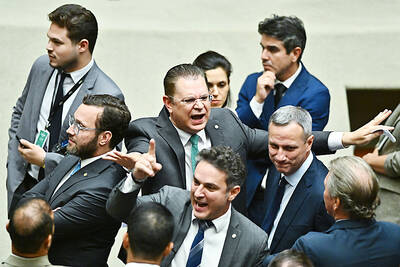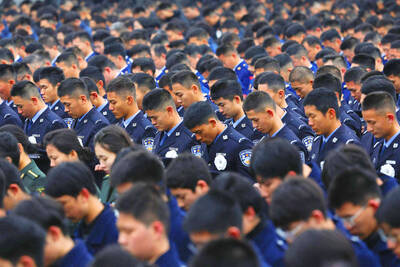China is to crack down on "blindly" using foreign architects to design major public buildings as part of a drive to stifle costly architectural extravanganzas, state media reported yesterday.
The Construction Ministry has unveiled rules to deter officials from backing public buildings that waste money and electricity, Xinhua news agency reported.
A ministry spokesman said excessive enthusiasm for foreign designs was part of the problem.
"In recent years, in some places there's been a fever for international tenders for major public buildings, especially landmark projects," the unnamed spokesman said, according to the Chinese government's official Web site.
"Some foreign architects are divorced from China's national conditions and single-mindedly pursue novelty, oddity and uniqueness," the spokesman said.
China's feverish economic growth and the capital's preparations for the 2008 Olympics have underwritten a burst of spectacular but controversial buildings designed by non-local architects.
Among those under construction are the towering headquarters of China's central state television service, designed by Dutch architect Rem Koolhaas, and a National Theater in the political heart of Beijing -- a science-fiction metal and glass dome conceived by Frenchman Paul Andreu.
Xinhua reported in 2004 that Koolhaas' design would cost about US$750 million. These and other foreign designs have been derided by local critics for their cost and lack of traditional local flavor.
The ministry spokesman said new rules did not block foreign designers from bidding for big projects, but they sought to add "transparency" so local designers were kept in the running.
The regulations target officials channelling public money into "image projects" that "ignore national conditions and financial capacity", the spokesman said.
Major public buildings occupy less than 4 percent of urban built-up areas but use up 20 percent of electricity in such areas, the spokesman said.
The new rules demand that selection of designs focuses on cutting energy and water bills.

PARLIAMENT CHAOS: Police forcibly removed Brazilian Deputy Glauber Braga after he called the legislation part of a ‘coup offensive’ and occupied the speaker’s chair Brazil’s lower house of Congress early yesterday approved a bill that could slash former Brazilian president Jair Bolsonaro’s prison sentence for plotting a coup, after efforts by a lawmaker to disrupt the proceedings sparked chaos in parliament. Bolsonaro has been serving a 27-year term since last month after his conviction for a scheme to stop Brazilian President Luiz Inacio Lula da Silva from taking office after the 2022 election. Lawmakers had been discussing a bill that would significantly reduce sentences for several crimes, including attempting a coup d’etat — opening up the prospect that Bolsonaro, 70, could have his sentence cut to

China yesterday held a low-key memorial ceremony for the 1937 Nanjing Massacre, with Chinese President Xi Jinping (習近平) not attending, despite a diplomatic crisis between Beijing and Tokyo over Taiwan. Beijing has raged at Tokyo since Japanese Prime Minister Sanae Takaichi last month said that a hypothetical Chinese attack on Taiwan could trigger a military response from Japan. China and Japan have long sparred over their painful history. China consistently reminds its people of the 1937 Nanjing Massacre, in which it says Japanese troops killed 300,000 people in what was then its capital. A post-World War II Allied tribunal put the death toll

A passerby could hear the cacophony from miles away in the Argentine capital, the unmistakable sound of 2,397 dogs barking — and breaking the unofficial world record for the largest-ever gathering of golden retrievers. Excitement pulsed through Bosques de Palermo, a sprawling park in Buenos Aires, as golden retriever-owners from all over Argentina transformed the park’s grassy expanse into a sea of bright yellow fur. Dog owners of all ages, their clothes covered in dog hair and stained with slobber, plopped down on picnic blankets with their beloved goldens to take in the surreal sight of so many other, exceptionally similar-looking ones.

‘UNWAVERING ALLIANCE’: The US Department of State said that China’s actions during military drills with Russia were not conducive to regional peace and stability The US on Tuesday criticized China over alleged radar deployments against Japanese military aircraft during a training exercise last week, while Tokyo and Seoul yesterday scrambled jets after Chinese and Russian military aircraft conducted joint patrols near the two countries. The incidents came after Japanese Prime Minister Sanae Takaichi triggered a dispute with Beijing last month with her remarks on how Tokyo might react to a hypothetical Chinese attack on Taiwan. “China’s actions are not conducive to regional peace and stability,” a US Department of State spokesperson said late on Tuesday, referring to the radar incident. “The US-Japan alliance is stronger and more